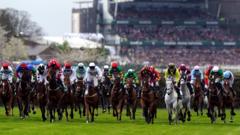
The Grand National has historically held a special place in the hearts of the general, non-racing public. It was a unique, unpredictable race that inspired friends to get together, families to have a flutter and workers actually to go into the office for a sweepstake.
But the changes that have been made to it recently are rapidly eroding that appeal and will destroy the popularity of the race.
Once the public realises that the most expensive horses from the top yards are cleaning up every year, and there are no more romantic, epic David-felling-Goliath triumphs, the folklore of the race will be dead.
Lowering the fences, shortening the race and reducing the number of runners all crept in to pacify the hypocrites who keep dogs in captivity, wear leather shoes and eat a traditional Sunday roast, but thought the National was too dangerous. But if the popularity that it still just about commands is to be preserved, it is essential that a genuine difference between the Grand National and other top races, such as those run at the Cheltenham Festival, is restored.
In recent weeks, many trainers have suggested changes to correct this slide into normality.
One suggestion that is gaining traction is to limit the number of runners any owner or trainer can participate with. While regular racegoers are not overly bothered by who owns or trains the horses, allowing the big guns to ‘flood out’ the opposition is now a real threat to the appeal of the Grand National among the wider public.
It would, for example, feel pretty odd to them if Ferrari could run unlimited cars in a Grand Prix – the National is not so different.
As far as keeping the race unique is concerned, an extreme test of stamina is now the only thing that can set the Grand National apart from other races, now that the fences have been neutered to the point they are more of a trip hazard than a challenge.
So instead of dropping the distance back to four and a quarter miles, it should actually be increased to four and three quarter miles. This would put off the top three-mile chasers, which is a good thing. The endeavour should be to give the super-staying horses a chance to excel.
It follows that there should be a series of Grand National qualifying races throughout the season which create a proper narrative into a fitting finale. Some of those races already exist, but others will need to be lengthened to become suitable trials for genuine staying chasers.

These changes will force trainers to decide at the beginning of the season whether they are going to train a horse with the Grand National as the ultimate target, taking in at least one qualifying race on the way, or whether their horse should be kept to shorter distances for the elite races.
Confining ...



